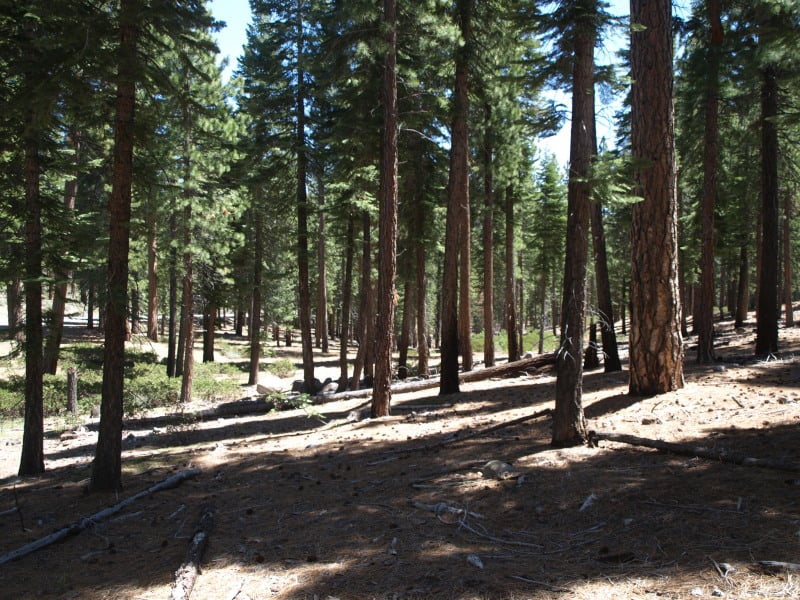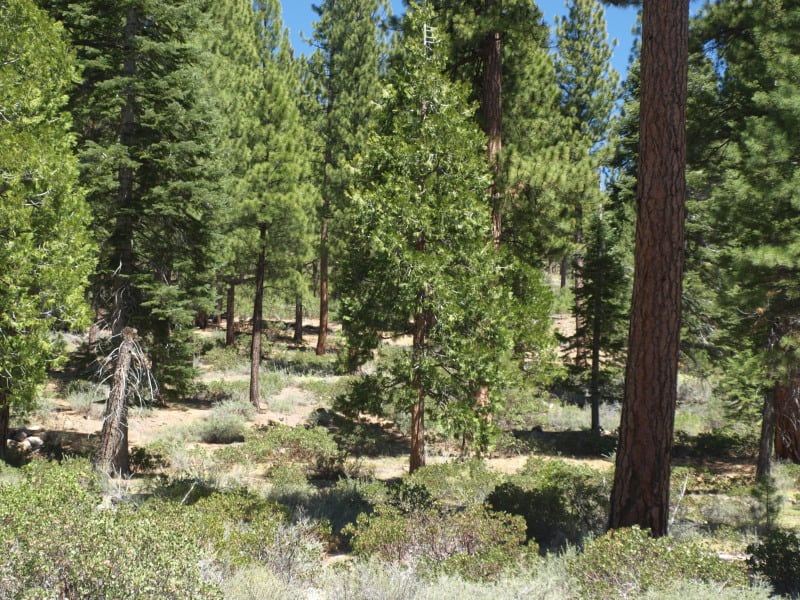In my last adventure, I decided to pass through an area of the Tahoe National Forest, where I worked in 1996 and 1997. During that time, I worked on fire salvage, blowdown salvage, insect salvage and roadside hazard tree projects. There was also this Service Contract, which reduced fuels without cutting trees over 9.9″ dbh. The logger had three varied types of cutting machines, each of them with their strengths and limitations. He was a crusty old guy, who didn’t like the Federal “oversight” of his work.
I usually liked to change these loggers’ perception of what inspectors do. He wasn’t used to getting “written up” for doing good work but, he was still quite wary of me. I once caught him damaging the bark of a leave tree with his machine, then getting off it, and applying some dirt to the wound (to hide it). As he was getting back to his seat, he saw me. I gave him the “naughty, naughty” hand signal, and walked over there. I waited to see how he would react to getting caught. Surprisingly, he kind of hung his head, and was quiet, for once. So, I told him that there is an acceptable level of “damage” in this kind of work and he wasn’t anywhere near close to it, yet. I think our relationship changed, a little, after that agreement.
One of the keys to success was the ability to do a cool prescribed burn. All too often, fuels are still too thick and the burn is a bit hotter than the residual trees can stand. In this case, the firefighters did well in achieving a nice, cool and effective burn. On the west-facing slopes, the brush has grown back, somewhat. That is to be expected, and will continue, until it is shaded out.
As far as resilience to fire and drought, it is pretty clear that the spacing is very good. The brush looks like it can be burned safely, on a regular basis. The pines also seem to be quite healthy and vigorous. Keep in mind, this area along Highway 89, in the eastside pine zone, is in a rainshadow east of the Sierra Nevada Crest. There are some western junipers up on the ridgetop, and the Nevada desert is 15 miles away.




What a gorgeously managed forest and something I suspect virtually every owner (i.e., the American citizen) would like. It is too bad the “anti’s” are so hung up on the process that the product gets lost. It is too bad the anti’s have gained so much power in DC that they presume to speak for the American citizen – they don’t.
Larry, Beautiful! It’s always rewarding to re-visit project you’ve worked on that have turned our well. I have some of those… and also some that haven’t (planting slash pine on longleaf sites in Florida). But even the bad ones have some benefits (the slash pine is now merchantable and being cut, at a profit, to restore longleaf). Thanks for the photos and the memories.
The prescription in these pictures looks pretty good to the human eye, but (i) there is a lack of dead wood, and (ii) the trees are too evenly spaced, needs more clumping.
In my neck of the woods, there are a LOT of projects like this that get done without appeals and litigation. Thanks to the diameter limits in the Eastside Screens.
Larry said “the brush has grown back, somewhat. That is to be expected, and will continue, until it is shaded out.”
This is an important point. Heavy thinning actually stimulates the growth of ladder fuels. Maintaining canopy cover helps suppress growth of ladder fuels.
If they were doing sincere fuel reduction, the agencies should focus exclusively on surface and ladder fuels and just ignore canopy fuels. But the valuable wood is attached to canopy fuels, so that’s what they end up going after.
Jim Agee says “Reduce Crown Density • Important to address once surface fire and torching are addressed. • DON’T START HERE!!!!! … Treatments that reduced surface fuels, treated ladder fuels, and kept the big trees fared best.” Risk Assessment for Decision-making Related to Uncharacteristic Wildfire, Conference Portland, Oregon Nov 17-20, 2003.
Models show that maintaining canopy cover is a useful way to reduced fire hazard, while removing canopy increases fire hazard.
Rutherford V. Platt, Thomas T. Veblen, and Rosemary L. Sherriff. 2006. Are Wildfire Mitigation and Restoration of Historic Forest Structure Compatible? A Spatial Modeling Assessment. Annals of the Association of American Geographers, 96(3), 2006, pp. 455–470.
Of course, you are assuming that large trees were taken out of this project. I did say that only submerchantable trees were taken, with the best being left to grow and thrive. Also, remember that the Sierra Nevada has had diameter limits for over 20 years now, as well as a ban on clearcutting. This area is a fire-prone area on the fringe of the pine forests. There is no easy way to get more wood on the ground when fires are so frequent. One cannot get clumps where you want them. Besides, most of the clumps were brush, including mountain mahogany and junipers. Yes, there were also doghair thickets of small pines, too. The project was actually a shaded fuelbreak, along both sides of the highway. This being a deer migration route, it is good to not have clumps. Ironically, I hunted this area, with my two Uncles, when I was a kid. I saw a spike but couldn’t get a clear shot at it.